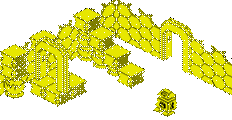Secret Weapons of Commodore - the Other Intellect
The Other Intellect/TOI Series and the Colour PET
Click the Commodore icon to return.
Intending to use pictures or text from this page? Please read this notice.
Last modify 29 December 2004.
The history of The Other Intellect is absolutely the most significant
story in Commodore's history, as it is the explanation of how Commodore
transitioned from an almost exclusively business electronics concern
to a major player in home computing. Without its development, the face
of computing might have been irrevocably changed ...
Sirius/Victor 9000 Page (information on the Victor 9000)
History of the Apricot PCs (Victor 9000 history)
The Colour PET
Portrait of the Colour PET (.jpg, 52K, courtesy Bo Zimmerman)
aka Color PET, CBM 8033?
Introduced Never officially. Known to have been developed sometime before
the VIC-20, so existed no later than 1979 or 1980.
Hardware Unknown. Likely based on the 8032, with an unknown graphics
architecture. Enhanced firmware for the new graphics mode and colour
support.
Graphics and Sound Beeper sound at best. 160x100x8 graphics, 80x25 text.
Eventual Fate Scrapped prototype. Part of the design may have been integrated
into the early VIC-I video chip.
See below for comments on both systems.
The Other Intellect
Thanks to Mike Stein for the Cursor issues behind this entry.
aka ???
Introduced Never officially. An early demonstration model appeared at
Winter CES 1980.
Hardware, Graphics and Sound Unknown in the prototype. Likely 6502-based
with an early VIC-I.
Eventual Fate Unclear and contradictory, but Cursor, the most direct
reference to TOI in the literature, implies that it was transformed
into the VIC-20.
Comments
Jim Brain speculates in Commodore Trivia #26 that "The Other Intellect",
or TOI series, may have been the Colour PET being designed by Chuck
Peddle, founder of MOS Technology (later Commodore Semiconductor Group);
the Colour PET, mentioned in The Home Computer Wars, mysteriously disappeared
from view shortly before the VIC-20's development. The Colour PET, also
known as the CBM 8033, appeared briefly at CeBIT and several other fairs
around 1979-80. Described by Dr. Peter Kittel as "a rather dirtily
hacked prototype," the machine had CBM 8032 electronics in a 2001
series case (Mike Shartiag) with an NEC monitor rather clumsily incorporated
into the housing (as demonstrated in Bo's photograph above).
Despite the Colour PET's unpolished but nevertheless palpable technical advancement, it didn't appear to be what Tramiel wanted for market placement with the home computer invasion starting to pick up steam. (Its likely pricepoint alone would have made it very unattractive to home users.) Come Winter CES 1980, Cursor reported on a strange prototype "home computer" that could attach to a television set, and 'flash pretty patterns on the screen.' In April, Commodore finally coughed up further information and announced The Other Intellect, a new low-end computer that was intended for the home and had TV graphics and sound capabilities.
In May 1980, Commodore started to make louder noises about the imminent release of the Colour PET, but just as quickly, both the Colour PET and TOI suddenly disappeared. However, in September, was it TOI that suddenly resurfaced as the VIC-20 ... ?
Nevertheless, while the Colour PET was dead, it was not forgotten. Portions of its ideas may have been carried over into the short-lived VIC-40, as well as into other non-Commodore machines as well: the Victor 9000 is a very likely suspect (even more likely given the fact that Chuck Peddle was behind it). Manufactured by Sirius Systems Technology of Scotts Valley, California, this unusual yet surprisingly common early 1980's 8086-based computer, nominally PC compatible (in those days), had several interesting features, including an extremely detailed, powerful graphics subsystem with the then-intriguing ability to control monitor gamma in software, variable-speed 5.25" drives with a Commodore-like controller, and a sound system based on a synchronous serial chip driving a CODEC IC that could even take sound input, unheard of on a PC in those days. Also known as the Sirius 1, its unusual disk format made it difficult to work with or run software on, despite being able to use MS-DOS (an unusual internationalised "version 1.25"), UCSD P-System and









